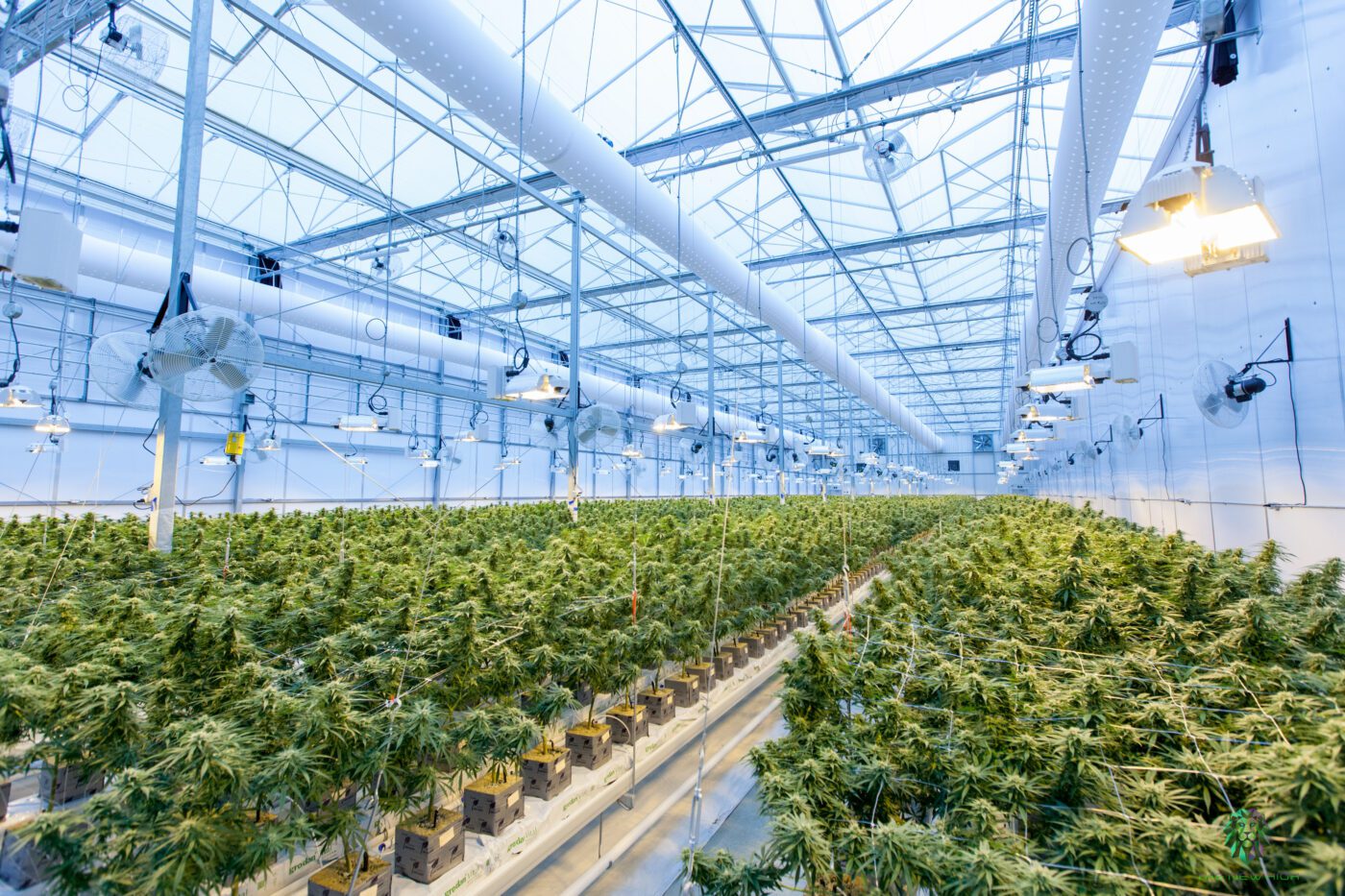Growing cannabis en masse is an art perfected over many years of study and trial and error. There are thousands upon thousands of web sites out there devoted to the dissemination of knowledge about our favorite green. Every possible occurrence of disease, ailment, or irritation has been experienced and reported by someone out there.

The absolute pinnacle of your cannabis growing career would be to commit an entire greenhouse to its growth. Go all-in, and plant thousands of the things! Just imagine what that field of green would look and smell like at the peak of all of the wonderfulness that is a mature, harvest-ready crop of cannabis.
Today’s greenhouses are functionally and technologically advanced. There are surprisingly few manufacturers offering single-use or close to single-use greenhouses. Most seem to be striving to cater, at least a bit, to the great, emerging monetary beast that is the legal cannabis trade by offering products and services that cater to this new niche.
Exploring your hydroponic green thumb inside a greenhouse of any size is a venture worth undertaking. The main goal of your future greenhouse grow op is to maintain an even and optimum growing environment for our favorite green. Modern greenhouses are at the peak of modern engineering and high-tech materials science. Gone are the days of cheap plastic stretched over rust and corrosion-prone steel frames.
Rust-resistant, corrosion-free aluminum base bars and frames have replaced wooden beams as the preferred material. The modern multi-walled polycarbonate panels and coverings diffuse direct sunlight and help keep you and your green warm in the colder months and cool in the warmer periods. Polycarbonate is a strong flexible plastic that is generally impact-resistant and less expensive than glass.
As they say, if it’s too chilly for you, it is for the greens, too. If you spend half an hour in the grow area, and your nose is cold, increase the temperature. If you let it get too cold, your plants will actually go into hibernation. Because of this, it is commonplace to find that greenhouse manufacturers that take the local environment into consideration offer models that are able to provide a measure of protection from the elements. Supporting a high snow or wind load or regulating temperature, for example.
There are greenhouse models that are designed to go both up or down in temperature and loads, according to local climate. You obviously wouldn’t need an extremely sturdy, four-season frame and covering if you lived in Arizona or another warm, southern region. On the flip side, Canadian winters require extra sturdy roofs to support all of that snow. Greenhouses made for growers in the northern latitudes are extremely sturdy.

Four-season greenhouses have at least a double layer of polycarbonate covering or multilayer tempered glass. Greenhouses must withstand snow loads of between 30 to 50 pounds per square foot (13.6 to 22.67 kilograms) and winds up to 95 miles per hour (144.84 kilometers per hour).
All panels and coverings I’ve seen and used over the years have been UV-protected to block harmful UV rays. Manual roof vents, rain gutters, and aluminum bases are the standard in most models. Smart technology and engineering have made it possible to offer automatically adjusting vents and other heating and cooling options that operate completely without human supervision. Simply set them once, and let them run.
R Value is an important metric to know. An R Value tells you how well a type of insulation can keep heat from leaving or entering your greenhouse. Common materials and covering options are available from thicknesses of 3 mm to 16 mm and R Values up to 3 or even slightly more. The higher the R Value, the greater the insulating power. Single pane tempered glass (3 mm) has an R Value of .95. Double-pane tempered glass (6 mm) increases R Value to 2. Double-wall polycarbonate commonly ranges from 4 mm to 10 mm and Ra Values from 1.43 to 1.89. Triple-wall polycarbonate (16 mm) goes up to an R Value of 2.5. Five-wall polycarbonate (25 mm) adds an R Value of 3 to 4.
The average cost of any given greenhouse is about $25 per square foot. For comparison, the cost of a two-car garage in North America is about $40 per square foot. The huge size and quality difference of greenhouse models available for purchase means that this number fluctuates by quite a bit.
Decent residential, home solutions can be had starting at about $200. The cheapest of these are generally only used for a season or two before they essentially disintegrate. Or they are so small and insubstantial that they blow over in a wind, taking your plants with them. As with most things, mass production lowers costs for individual products which are then offered to the end consumer on the cheap. However, sometimes quality is sacrificed for price.
Greenhouses scale up in a really amazing way. If you’re the ambitious type, most companies have optional do it yourself packages as well. They even ship all of the hand tools you’d need to put the thing together yourself and offer over-the-phone technical support should you have questions or run into problems.
Keeping your current carbon footprint as low as possible is of paramount importance to our future generations. Using alternative, renewable energy and sustainable production methods such as solar or wind energy reduces your overall carbon footprint.
In order to help offset the cost of a solar panel installation, most states and provinces in North America have introduced incentives and rebates to entice citizens to adopt clean, environmentally responsible energy solutions. These rebates encourage more people to go solar, as well as help those who already have, to offset the cost. Rebates return a portion of the cost, to help more homeowners handle the cost and effort of going solar. In addition to solar rebates, there are also other clean energy incentives to help make your workplace energy efficient.
If at all possible, recycle excess water and nutrient solution and collect rainwater. An operating greenhouse requires huge amounts of water. It is said that cannabis requires seven to 12 liters of water a day to grow one plant in a healthy manner. That’s lots of water.
A few words must be said about local laws. Cannabis in pretty much any form is legal in Canada and most states. However, licenses must be obtained to grow the stuff in any large numbers. It is widely accepted that growing cannabis is a privilege, not a right.
Since we’re all interested in growing the best grass possible, it also makes sense that there be a product designed specifically to grow it in. Most greenhouse manufacturers now have blackout greenhouses designed for cannabis as a standard model, kept in stock. If at all possible, consider an energy-efficient greenhouse specifically designed for cannabis production.
Both active and passive ventilation should be in use. By passive ventilation, I mean the natural air flow that is caused by invective cooling: the air moves as a result of warm, rising currents and cool, descending currents. No machines or moving parts are part of convection. Essentially, active ventilation includes electric fans and such.
Many manufacturers of greenhouse equipment offer metal framing systems designed specifically for hanging grow lights from. Greenhouses for cannabis need to be artificially regulated micro-environments.
The temperature difference between the northern and southern ends of North America varies about 60 degrees Celsius (140 degrees Fahrenheit). Cannabis will not really grow under the faint winter sun in the northern latitudes of our planet. The plants will not bud or grow well. They will have spent all of their possible total energy obtaining height to reach a feeble light source. The plant will be spindly and weak and pathetic. This is known as phototropism.
Artificial lighting allows for the complete control of the environment inside your greenhouse. There are many solutions for lighting, but by far the top two lighting flavors are high pressure sodium (HPS) and metal halide lighting. Each has its pros and cons, and both work well. For example, a 1000-watt lamp of either will produce enough light to cover an area of 36 square feet, which is a 6-foot wide square (about 2 meters).
For more practical reasons, it is recommended that you purchase a ballast that can accommodate both HPS and metal halide bulbs with the flick of a switch. This way you don’t have to have a really beefy apparatus that would be required if you added two separate sources of great weight — ballasts are very heavy. You would also save yourself big money, as you’re simply buying less.

Because I’ve mentioned that the greenhouses be blacked out, a few words have to be spent on the need for light deprivation schedules. Cannabis can be made to flower by changing the light cycle from an 18-hour-on, 6-hour-off foliage growth period to a 12-hour-on, 12-hour-off flowering period. The days must be bright but more importantly, the night must be completely black. This is why I have recommended a black-out covering.
Some might only want a summer crop that will keep them smoking through the winter. Some might do it for the money. Whatever your idea of a cool crop is, by all means, do it in an environment you have complete control over: Do it in a greenhouse. Just do some studying. Think it through. Keep up with the chores. It’ll be worth it in the end, I promise. Good luck.
Thomas Valentine lives in a small town on the shores of the Red River in Manitoba, Canada. He has been a lifelong cannabis horticulturist and advocate of the legalization of marijuana, worldwide.

